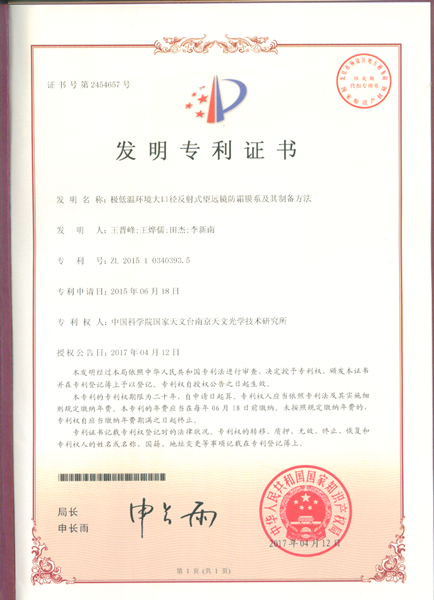Mirror frost-proof is a difficult problem that must be overcome for astronomical optical instruments in the alpine region represented by Antarctica.
Although Antarctic Dome A has the lowest water vapor in the world, its relative humidity is often saturated.
When the temperature of mirror is lower than the ambient environment, frost will cover the mirror.
The frost on the mirror not only reduces service life of the film, but also seriously affects the scientific observation of the telescope. Therefore, frost-proof and defrosting become very important.
Frost- proof of ITO film was successfully used in the CSTAR telescope for the first time by Nanjing Institute of Astronomical Optics & Technology (NIAOT).
It was only suitable for the transmission optical path which was not able to be used in reflective optical system with large aperture.
Based on solving the above problems, the research group of coating technology of NIAOT developed a frost-proof reflection film system with ITO conductive film layer (see figure 1) to control the heating power of conductive film by accurately measuring environment and mirror temperature.
The mirror temperature is slightly higher than the ambient temperature which can prevent frosting. This method has been successfully verified by experiments, which can provide a strong technical guarantee for the smooth construction of large-aperture reflective astronomical telescopes in Antarctica and extremely low temperature area.
Method of frost-proof film system for large aperture reflective telescope in extremely low temperature environment was authorized by Chinese invention patent in 2017 (patent number: ZL 201510340393.5) and American invention patent in 2019 (patent number: US10359621B2) .
Anti-frost reflective film system can not only be used to defrost but also ensures that average spectral reflectance of the mirror can be better than 98% in the waveband range from 400 nm to 2000nm.

Figure 1 Ф520mm spherical mirrors with frost-proof reflective film system

Figure 2 Chinese patent certificate for invention

Figure 3 United States patent certificate for invention